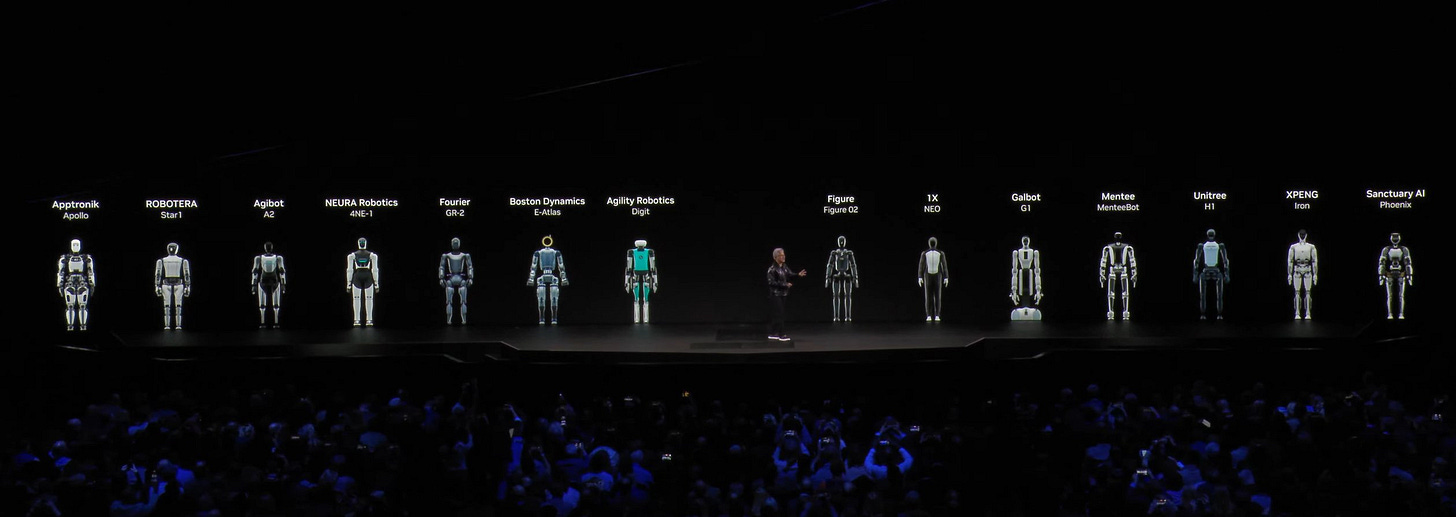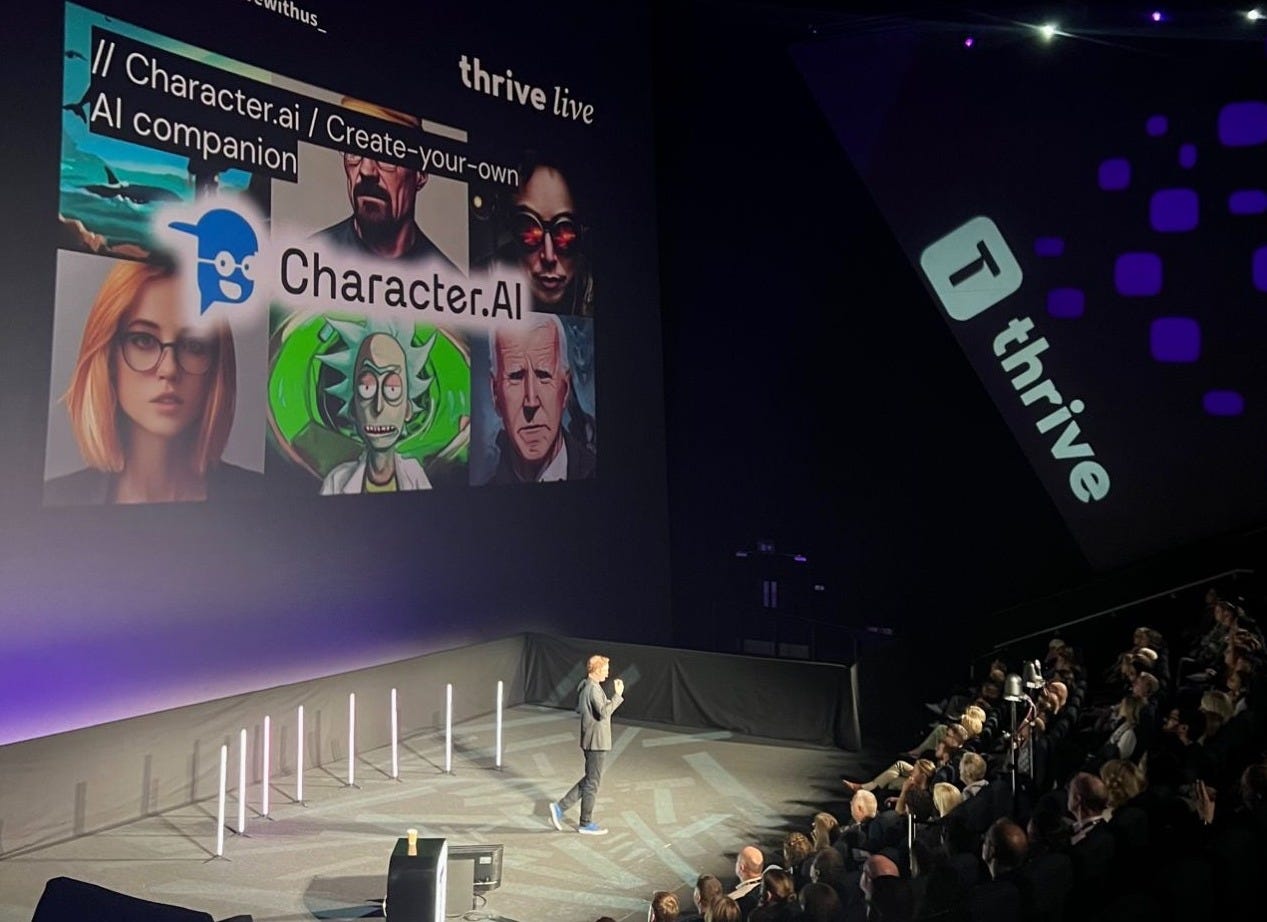The mundane duality of exponential change – from CES' humanoid robots to AGI's delayed social impact.
⏩ Future Normal: Fast Forward #117
Many of you might be still easing into 2025, which is why this week I want to talk less about specific innovations and instead share a mental model to help you better navigate through the current moment.
(Spoiler alert, it will also make you feel less guilty about taking some time off over the holidays. Which I hope you did)
As I write this, CES 2025 is wrapping up. This year, humanoid robots were everywhere. I’m not going to round up all the startups and models on show in Vegas (thanks Perplexity!). Instead, I’m more interested in exploring what widespread robots will mean – especially when it comes to brand and customer experience.
Fortunately I wrote about this last year, after CES 2024 (!):
For executives and marketers however, the biggest strategic question when it comes to robots isn’t “will we use them?” (short answer: you will), but “how and where will we integrate them into our brand and customer experience?”
Because the world will fragment into two camps: those brands that lean into robots to deliver a low/no-touch automated experience, and those that move in the other direction and focus on delivering high-touch, human-led experiences (keeping their robots largely out-of-sight from their customers).
The obvious prediction will be that premium brands will employ humans to serve their customers, while mass market brands will leverage robots to automate as much as possible.
However I suspect it will be more nuanced, and that countless fascinating new, robot-adjacent roles will emerge. For example, imagine a coffee shop which uses robot baristas to make its coffees (every one bespoke and perfect, of course). Could the time that the human baristas save mean that, instead of being stuck at the coffee machine, they could be out in the shop with customers – educating them on the product they’re buying and so increasing their enjoyment?
So – which type of brand will you be when it comes to robots and your customer experience? And what new robot-related roles will emerge in your organisation?
This framing still holds up well.
But the real reason for quoting a year-old piece at length is to remind you of a deeper truth when it comes to trends and change.
Despite the hype around exponential technological change, most things change far slower. Behaviours, meaning, organisations, systems – these are areas that will evolve, rather than fracture overnight.
Thriving in the future normal requires you to operate in two lanes. You need to see what’s happening at the frontier now. But you also need to understand how these shifts will ripple back into mainstream, ‘normal’ life.
How will they change the work your people do? How will they change your organisational culture? How will they change the expectations of your customers?
And equally, what won’t they change?
A note from our sponsor (me!). Many readers discovered me via my keynotes. If you’re lining up your next strategy session, sales kick off, or customer conference – 🚨 I’d love to help.🚨
Typically I inspire clients with:
Your Future Normal: a trend keynote, bringing you non-obvious yet deeply relevant insights from outside your industry.
VisuAIse Futures: a new interactive, ‘multiplayer’ AI-powered experience to unleash your team’s creativity. Watch the 2-min highlight video.
Read more about these at the bottom of this email, or reach out to Renee Strom on renee@ideapress-speakers.com.
And even if I’m not a good fit, then do check out the best speakers I saw in 2024.
AGI. Is it coming? Will we notice?
Talking of the frontier, one of the other big emerging 2025 narratives (at least among certain members of the AI illuminati) is that AGI – Artificial General Intelligence – is increasingly close.1
While I’m highly aware of Sam Altman’s motivations in claiming Open AI will reach AGI soon, he did share an insight at the back end of last year which I think is both profound and reassuring to most readers of this newsletter:
To quote:
“[Achieving AGI] should be very crazy. But the second part of the prediction is that society itself actually changes surprisingly little.
An example of this would be that if you asked people five years ago if computers were going to pass the Turing test, they would say no. But then if you said, well, what if an oracle told you it was going to? You would say it would be this crazy, breathtaking change for society.
But we did kind of satisfy the Turing test, roughly speaking. And society didn't change that much.”
(NB/ he does caveat that in the longer term – i.e. multi-decade – horizon, society will hugely change)
Again, this should reassure you. Yes, your children will do jobs we can’t even imagine yet, and will be savagely blasé about experiences that would blow our minds today. But don’t kid yourself – we’re not all going to have AI agents managing our lives in the next 12 months.
As Bill Gates said, “People often overestimate what will happen in the next two years and underestimate what will happen in ten.”
My challenge to you for 2025 is to be more relaxed about the short term, and more ambitious about the long term. Don’t let the inertia and relative stability of the coming months blind you to the radical opportunities ahead.
Good luck!
More glimpses of the future normal
Gen AI’s hallucinations can unlock new scientific breakthroughs. I’ll be talking a lot this year about how gen AI can invigorate your innovation culture, used right.
Verdiva Bio raised $410 million to develop its GLP-1 drug – its planned USP is that it will be a weekly oral dose (rather than injected). Now we need an Ozempic for climate.
Ray-Ban Meta glasses get Live AI – AI meets the real world.
A new wearable ultrasound patch from UC San Diego provides continuous, noninvasive blood pressure monitoring. The idea that we walked around in such ignorance about our bodies will be mind-boggling to future generations.
German Bionic’s Apogee Ultra is a robotic exoskeleton that enables makes lifting 70 pounds feel like 10 pounds. What will be more commonplace – robots, or augmented humans? And beyond workers, what about extending independence for the elderly?
What if forever chemicals weren’t forever? Researchers have found a way to break down PFAS using light.
Are you ready for 2025?!
In 2024 I delivered 30+ sessions, both live and virtually – from Brazil to Saudi Arabia, Las Vegas to London.
My regular trend & innovation keynotes bring fresh, cross-industry, people-first perspectives to your audience.
VisuAIse Futures takes it one step further, turning a keynote into an interactive, ‘multiplayer’ creative experience. Here’s what people are saying about it:
“It was so refreshing to hear how AI can be used to power human imagination, rather than replace it. And then it was even better to actually experience it”
“Fantastic session! Hugely insightful and fun, too!”
“Brilliant. The feeling in the room was positively intense whilst the images were coming through!
Feel the optimistic vibes it will bring to your event in the 2-minute video below (or watch it here).
If you’d like to discuss bringing me to your next meeting or event then please do reach out directly to Renee Strom or check out my speaking site.
Thanks for reading,
Henry
Ethan Mollick notes there are a number of issues with these predictions – primarily that no one really knows exactly what AGI is, beyond a loose idea of “machines that can outperform expert humans across most intellectual tasks.”



